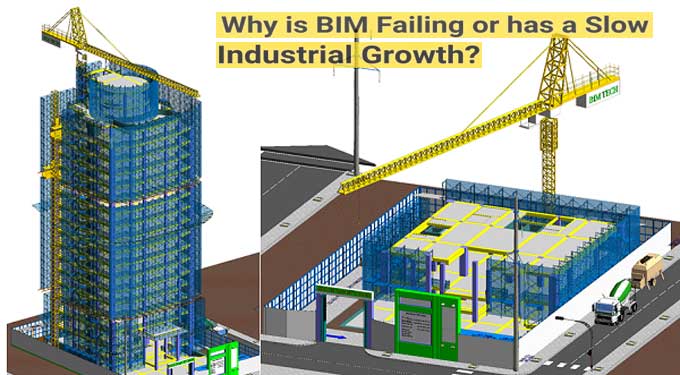The Reasons behind BIM's failure and its slow Industrial Growth
Tweet
A major player in the construction industry, Building Information Modeling has emerged as one of the most efficient working ways. The market undergoes digitization, so has BIM, especially over the past decade. Some industry critics still believe that BIM hasn't lived up to expectations and has been very slow to gain widespread adoption among industry professionals.
We conducted extensive research and consulted with BIM experts before concluding that BIM failure exists or not. Construction projects of all shapes and sizes can now benefit from BIM, which contributes to the building of a new tomorrow.
Problems with BIM Adoption
Even with BIM's enthusiasm and awareness, there are still several factors inhibiting its growth. One of the biggest obstacles to the adoption of this technology is a lack of demand from clients.
In the private sector, Building Information Modeling is not a requirement, and if it uses on smaller projects, it is a duplication of effort. Despite the advantages offered by technology that is independent of project size and the ability to detect clashes is the same in every project, if the use of technology is not of primary importance to the client, designers let it slide.
In addition to the managers, they must realize the importance of BIM and stop focusing on the training and software costs. For small-scale businesses to improve their adoption rate, it is important to explore incorporating BIM into their work culture while reducing the cost.
Costing
There was a consensus that we should wait until the downturn ended before looking at Building Information Modeling. With the recession, people are being more cautious about spending money. There is no denying that the move involves software, training, and time expenditures.
It is important to weigh the potential benefits against the associated costs. Those who adopted BIM have found the experience to be better than they expected.
Lack of In-House Experience
Another obstacle to adoption is the lack of training and expertise. Study results show that even after 90% of engineers know about the importance of BIM, only 50% are knowledgeable about it. Training people will need first, and until then, hiring the right people must be done to fill this gap.
Working on too Small Projects
A Building Information Modeling can use for projects of any size, including domestic renovations. Whether the drawing is 2D or 3D, the quality of the survey is what most impedes its effectiveness. In the beginning, small contractors may be hesitant to adopt the technology. While the workplace undergoes constant change, it is still possible to gain benefits in the early phases of a project.
Building Information Modeling wasn't a good fit for professionals working in small practices with less than five employees. The fact is that even domestic projects can be complex, even if they don't seem complex enough to warrant Building Information Modeling.
Less Demand of Clients
Although the Government is mandating BIM for publicly-funded projects, clients of smaller organizations don't always make the same demands, and the smaller they are, the less likely it is. More than seven in ten practices with fewer than five employees cited this factor.
Wrapping it Up
According to the study, adoption of the software has grown by almost 70 percent. This method of designing using 3D models considers as a solution to many construction reliability and sustainability crises. That is also a means of attracting young brains to contribute to the industry's growth.
To get online demonstration, watch the following video tutorial.
Video Source: Autodesk University
It is encouraging to know that only 4% of organizations wish they hadn't adopted BIM despite reluctance to do so. If they don't adopt BIM, 59% of organizations fear being left behind. There is unrelenting pressure on architects' and other professionals' fees, and it appears that Building Information Modeling could offer a way to attract more work and make that work more profitable.
We know from the experiences of those who have adopted BIM that the process is worth the effort, even if it is not easy.

Gallery
Feel free to contact us for BIM requirements. One of our representative will respond you within 24 Hours. Send us your projects requirement today and grow your project.
Explore More !







